The ancient Roman city of Pompeii, entombed beneath layers of volcanic ash, provides a unique window into the past. Visitors can walk the well-preserved streets, marvel at remarkable frescoes, and ponder the haunting plaster casts of victims. Exploring this archaeological treasure trove, one can’t help but imagine the vibrant life that once thrived here – until the catastrophic eruption of Mount Vesuvius brought it all to a sudden and tragic end.
Key Points
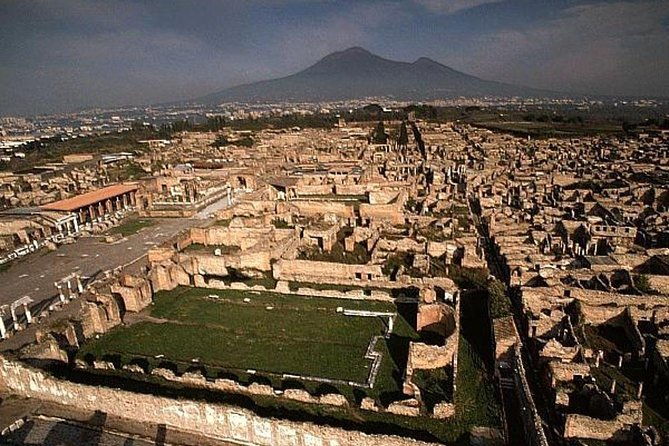
- Pompeii offers a remarkable glimpse into daily life in an ancient Roman city, frozen in time after the eruption of Mount Vesuvius in 79 AD.
- The excavated ruins reveal well-preserved streets, homes, markets, and public baths, providing cultural insights through artworks and artifacts.
- Visitors can explore architectural wonders like the grand amphitheater, Villa of the Mysteries, and the Thermopolium, an ancient fast-food hotel.
- The site offers an immersive experience of ancient Roman civilization, with vivid frescoes, mosaics, and haunting plaster casts of victims.
- Ongoing preservation efforts, including stabilization techniques and regular excavations, ensure the continued protection and study of this archaeological treasure.
Overview of the Archaeological Site
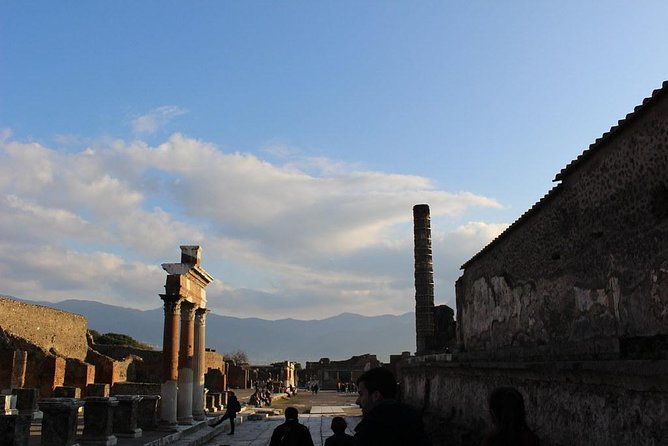
The Archaeological Site of Pompeii provides a unique glimpse into the daily life of an ancient Roman city.
Frozen in time after the deadly eruption of Mount Vesuvius in 79 AD, the excavated ruins reveal the bustling streets, homes, markets, and public baths that once thrived here.
Visitors can explore well-preserved structures, artworks, and artifacts that offer insights into the culture, commerce, and architecture of this vibrant metropolis.
Though a tragic event, the destruction of Pompeii has left an invaluable archaeological legacy that continues to fascinate and educate people worldwide.
Looking for more options in Naples? We've reviewed plenty of other experiences.
Exploring the Ruins of Pompeii

Visitors to the Archaeological Site of Pompeii can enjoy the captivating remains of this ancient Roman city.
Wandering through the well-preserved streets, they’ll discover the remnants of homes, shops, temples, and public baths that once bustled with life. Highlights include the iconic Amphitheater, the Forum, and the dramatic plaster casts of victims preserved in their final moments.
Exploring the site’s many ruins and artifacts provides a vivid glimpse into the daily lives and tragic fate of Pompeii’s residents.
Exploring Pompeii’s ruins and artifacts provides a vivid glimpse into the daily lives and tragic fate of its residents.
With knowledgeable guides to bring the past to life, visitors can gain a deeper understanding of this remarkable archaeological treasure.
Discovering Architectural Wonders
One of the most captivating aspects of the Archaeological Site of Pompeii is its well-preserved architectural wonders.
Visitors can marvel at the ancient city’s remarkably intact structures, which offer a glimpse into everyday life in the Roman era.
Key architectural highlights include:
-
The grand amphitheater, capable of seating up to 20,000 spectators
-
The intricately decorated Villa of the Mysteries, known for its stunning frescoes
-
The imposing Lupanar, or brothel, with its intimate rooms and erotic artwork
-
The Thermopolium, an ancient fast-food hotel serving up hot meals and drinks
These architectural gems provide a fascinating window into the past, allowing visitors to step back in time and enjoy the rich history of Pompeii.
Glimpsing Ancient Roman Life

As visitors explore the Archaeological Site of Pompeii, they’re transported back in time, glimpsing the vibrant daily life of ancient Romans.
The remarkably well-preserved streets, homes, and businesses offer a window into the past. Visitors can wander through shops, baths, and forums, imagining the bustling marketplace, the chatter of the crowd, and the rhythm of everyday life.
The vivid frescoes, mosaics, and artifacts provide intimate glimpses into the private and public realms of Pompeian society. From the iconic Amphitheater to the haunting plaster casts of victims, the site offers a profoundly immersive experience of ancient Roman civilization.
Visiting the Amphitheater and Gladiator Training Grounds
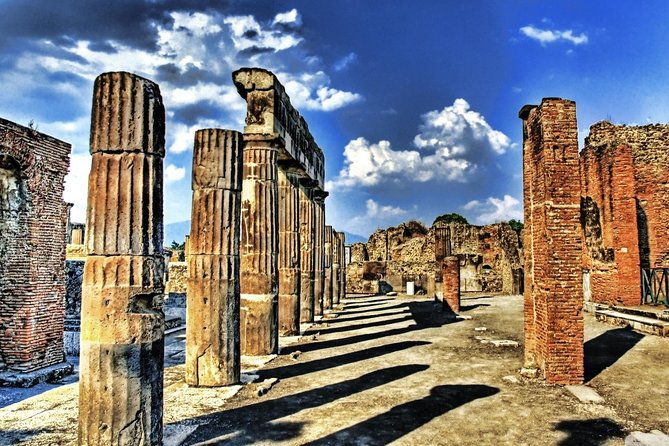
The iconic Amphitheater stands as the centerpiece of Pompeii’s ancient wonders, a testament to the city’s rich cultural heritage.
Visitors can explore the well-preserved gladiator training grounds, where warriors honed their skills before epic battles. The amphitheater itself offers a glimpse into the spectacles that captivated Roman audiences, from thrilling gladiator fights to dramatic theatrical productions.
Visitors can explore the well-preserved gladiator training grounds and witness the spectacles that captivated Roman audiences in the iconic Pompeii amphitheater.
-
Marvel at the architectural design and intricate details of the amphitheater
-
Imagine the roar of the crowd as gladiators clashed in the central arena
-
Discover the locker rooms and preparation areas used by the gladiators
-
Gain insights into the training regimens and strategies of these legendary warriors
- Herculaneum Small Group Tour and Ticket With an Archaeologist
- The Skull With the Ears: the Cult of the Dead in the Church of S. Luciella
- NAPLES DAYLIGHT – Day Trip From NAPLES
- Galleria Borbonica Entrance Ticket in Standard Route
- Naples Guided Tour by Bike
- Sorrento, Positano, and Amalfi Day Trip From Naples With Pick up
Uncovering the Tragedy of the 79 AD Eruption
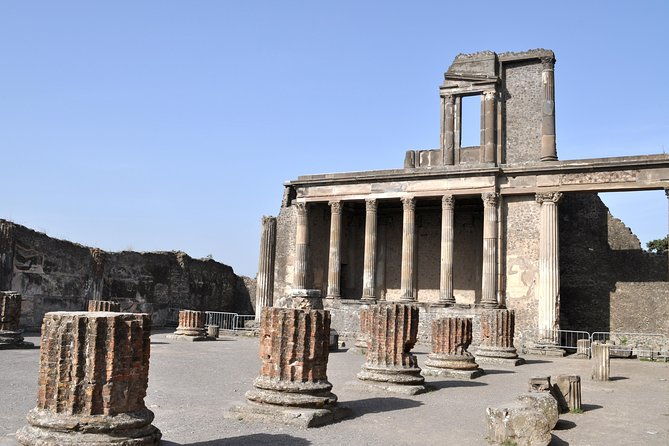
Though the amphitheater and gladiator training grounds captivate visitors, the true tragedy of Pompeii lies in the city’s devastating destruction during the 79 AD eruption of Mount Vesuvius.
Archaeologists have uncovered grim details of the catastrophe, revealing the harrowing final moments of the doomed inhabitants. Casts of victims’ bodies, preserved in volcanic ash, provide a haunting glimpse into the horror.
Excavations of homes, shops, and public spaces have unearthed everyday items that tell a story of sudden, violent death. Pompeii’s ruins stand as a somber testament to the power of nature and the fragility of human life.

How does one navigate the sprawling archaeological site of Pompeii? With over 20 hectares to explore, a thoughtful plan is essential.
Key tips to maximize your visit include:
-
Obtain a map and familiarize yourself with the layout prior to arrival
-
Prioritize must-see highlights like the Forum, Lupanar, and Villa of the Mysteries
-
Allow ample time – at least half a day to fully experience the ruins
-
Wear comfortable shoes and pack snacks/water to stay refreshed
With preparation and a spirit of adventure, visitors can enjoy the frozen-in-time wonder that’s Pompeii.
Preserving the Legacy of Pompeii
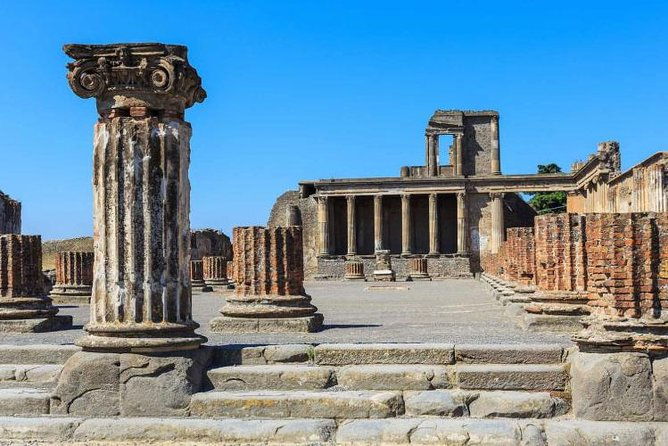
Preserving the legacy of Pompeii remains a paramount concern for archaeologists and historians alike. The site’s fragile ruins require meticulous care and conservation efforts to withstand the elements and prevent further deterioration.
Dedicated teams of experts use specialized techniques to stabilize structures, preserve artifacts, and mitigate the impact of tourism. Rainwater drainage systems, anti-seismic reinforcements, and protective coverings help shield the ancient city from natural threats.
Regular excavations uncover new treasures, necessitating thoughtful management of the site’s evolving landscape. Ongoing research and restoration projects ensure Pompeii’s captivating stories continue inspiring visitors for generations to come, safeguarding this invaluable window into the past.
Ask Away
Is Photography Allowed Throughout the Archaeological Site?
Photography is generally allowed throughout the archaeological site, but visitors should be respectful and avoid disrupting the experience for others. Some areas may have restrictions, so it’s best to check with tour guides or site staff.
Can Visitors Climb on or Touch the Ancient Ruins?
Visitors can’t climb on or touch the ancient ruins. Strict preservation rules prohibit interacting with the fragile archaeological artifacts to prevent damage. However, visitors can explore the ruins and take photos from designated viewing areas.
Are There Any Dining Options Available Within the Site?
There are no dining options within the Pompeii archaeological site. Visitors should plan to bring their own food and drinks, as there are no restaurants, cafes, or concession stands located on the premises.
What Is the Dress Code Recommended for Visiting Pompeii?
The recommended dress code for visiting Pompeii is comfortable, casual clothing. Wear sturdy, closed-toe shoes as the site has uneven terrain. Bring a hat, sunscreen, and water to stay cool and hydrated in the Mediterranean climate.
Can I Use My Drone to Capture Aerial Footage of the Site?
You can’t use your drone to capture aerial footage of the Pompeii site. The use of drones is prohibited within the archaeological area to preserve the site and ensure visitor safety.
Final Words
The Archaeological Site of Pompeii offers visitors a unique window into the everyday life of ancient Rome. Preserved in time, the city’s ruins provide a captivating glimpse of its vibrant past, from grand public spaces to intimate domestic settings. While the tragic fate of Pompeii’s residents is palpable, exploring this archaeological marvel is an immersive and unforgettable experience that illuminates the rich cultural heritage of the Roman world.
More Tours in Naples
- Naples: Old Town Tour with Veiled Christ and Cathedral
- Naples tour: from the Spanish Quarter to the heart of Vomero by funicular railway
- Naples: Guided Highlights Tour in Dutch
- Naples: Legends, Beliefs and History Small Group Tour
- Esoteric Naples: Secrets, Ghosts & Street Food Tour
- Baia: Semi-Submarine Tour for the Underwater City
More Tour Reviews in Naples
- Kalymnos: 10-Day Guided Climbing Trip, 6th-17th October
- Gulf of Naples: Sunrise Kayaking with Breakfast
- Naples: Old Town Tour with Veiled Christ and Cathedral
- Naples tour: from the Spanish Quarter to the heart of Vomero by funicular railway
- Naples: Guided Highlights Tour in Dutch
- Naples: Legends, Beliefs and History Small Group Tour
Still browsing? Here are more Naples experiences we've covered recently
- Discover 14 Great Lunch Experiences In Naples
- 14 Top Walking Tours In Naples (With Reviews & Prices)
- 14 Fantastic Workshops & Classes In Naples
- The 14 Most Popular Tours & Experiences In Naples
- Naples’s 14 Best Tours (With Prices & Reviews)
- We Rank The 12 Best Full-Day Tours In Naples
- 13 Best Wine Tours In Naples
- 14 Best Private Driver Services In Naples (With Prices)
- Naples’s 6 Top Shore Excursions
- Discover 13 Great Food Tours In Naples
- 6 Top-Rated Naples Dining Experiences
- You’ll Love These 11 Historical Tours In Naples
